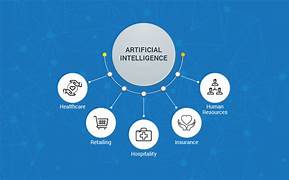How Will Advancements in AI Impact Job Security Across Different Sectors?
The rapid advancements in artificial intelligence (AI) have revolutionized industries, transforming how businesses operate and reshaping the global workforce. While AI offers countless opportunities for innovation, efficiency, and economic growth, it also raises critical concerns about job security across various sectors. As AI technologies become increasingly sophisticated, they bring both optimism and anxiety, sparking debates about automation, workforce displacement, and the future of work.
In this article, we will explore the potential impacts of AI on job security across different industries, examining the sectors most affected, the opportunities AI creates, and strategies to navigate this shifting landscape.
The Dual Nature of AI’s Impact on Employment
AI has a dual impact on employment: it automates routine tasks, potentially displacing jobs, while simultaneously creating new roles that require advanced skills. This duality is central to understanding its effects on job security:
- Automation and Job Displacement:
Many industries rely on repetitive and predictable tasks, making them prime candidates for AI-driven automation. Roles such as data entry, manufacturing assembly, and customer service are particularly vulnerable. The World Economic Forum predicts that by 2025, automation could displace 85 million jobs globally while also creating 97 million new roles. - Job Creation and Transformation:
While AI eliminates some jobs, it also generates demand for roles in AI development, deployment, and maintenance. Fields like data science, AI ethics, and machine learning engineering have seen a surge in job opportunities. Furthermore, AI enhances human capabilities, enabling workers to focus on creative, strategic, and interpersonal aspects of their roles.
Sectors Most Affected by AI Advancements
1. Manufacturing
AI and robotics have significantly transformed manufacturing, automating tasks like assembly, quality control, and inventory management. While this increases efficiency and reduces costs, it also reduces demand for manual labor.
- Job Threats: Factory workers, machine operators, and assembly line staff face displacement as automation takes over repetitive tasks.
- Opportunities: Roles in robotics maintenance, programming, and AI system management are on the rise, requiring reskilling and upskilling.
2. Retail and E-commerce
AI-powered technologies like chatbots, recommendation systems, and autonomous delivery vehicles are revolutionizing the retail sector.
- Job Threats: Cashiers, stock clerks, and delivery drivers may see reduced opportunities due to automation.
- Opportunities: E-commerce platforms require AI specialists, data analysts, and supply chain managers to optimize operations and enhance customer experiences.
3. Healthcare
In healthcare, AI supports tasks such as medical imaging analysis, drug discovery, and patient care management.
- Job Threats: Administrative roles, such as medical coding and billing, are at risk of automation.
- Opportunities: AI creates demand for healthcare technologists, bioinformaticians, and specialists in AI-driven diagnostics. Importantly, the human touch in patient care remains irreplaceable.
4. Financial Services
AI automates financial analysis, fraud detection, and customer interactions, improving accuracy and efficiency.
- Job Threats: Roles like accountants, financial analysts, and loan officers may decline as AI handles data-intensive tasks.
- Opportunities: New roles include AI algorithm developers, cybersecurity experts, and financial strategists who work alongside AI to interpret complex insights.
5. Transportation and Logistics
Autonomous vehicles and drones are transforming transportation and logistics, impacting jobs related to driving, delivery, and warehousing.
- Job Threats: Truck drivers, taxi drivers, and warehouse workers face potential displacement.
- Opportunities: Logistics optimization, fleet management, and AI system training offer new career paths.
6. Education
AI-powered tools like personalized learning platforms and virtual tutors are reshaping education delivery.
- Job Threats: Traditional teaching assistants and administrative staff may be affected by automation.
- Opportunities: Roles in AI-driven curriculum design, educational technology development, and virtual reality-based learning environments are emerging.
The Positive Impacts of AI on Job Security
1. Boosting Productivity
AI enhances productivity by automating mundane tasks, allowing employees to focus on higher-value activities. This shift can lead to job enrichment rather than job elimination.
2. Enhancing Skill Development
As AI reshapes industries, it fosters the demand for continuous learning and upskilling. Workers who embrace AI-related skills can transition into emerging roles and secure their place in the evolving job market.
3. Creating New Industries
AI innovation drives the creation of entirely new industries, such as autonomous vehicles, smart cities, and precision agriculture. These industries generate jobs that did not exist a decade ago.
4. Supporting Small Businesses
AI tools enable small businesses to compete with larger enterprises by automating marketing, customer service, and operational tasks. This democratization of technology can spur entrepreneurship and job creation.
Challenges and Concerns
1. Unequal Impact Across Skill Levels
Low-skilled workers are more vulnerable to displacement, as their roles are often more easily automated. High-skilled workers, on the other hand, are better positioned to adapt and thrive.
2. Widening Socioeconomic Gaps
The adoption of AI could exacerbate income inequality, as high-paying tech jobs concentrate in urban hubs while routine roles disappear in smaller towns and rural areas.
3. Ethical and Privacy Concerns
AI systems often rely on vast amounts of data, raising concerns about privacy, surveillance, and ethical decision-making. Addressing these issues is critical to ensuring a fair and inclusive AI-driven future.
4. Resistance to Change
Many workers and organizations resist adopting AI due to fears of job loss or lack of understanding. Overcoming this resistance requires effective communication and change management.
Strategies for Navigating AI-Driven Workforce Changes
1. Embracing Lifelong Learning
Continuous learning and upskilling are essential to staying competitive in the AI-driven job market. Governments, businesses, and educational institutions must collaborate to provide accessible training programs.
2. Supporting Workforce Transition
Policymakers should implement measures such as unemployment benefits, job placement services, and reskilling initiatives to support workers displaced by AI.
3. Promoting Ethical AI Development
Ensuring transparency, fairness, and accountability in AI systems is critical. Ethical guidelines and regulations can help mitigate the risks associated with AI deployment.
4. Encouraging Collaboration Between Humans and AI
Rather than viewing AI as a competitor, organizations should focus on integrating AI as a collaborative tool that enhances human capabilities.
5. Investing in Regional Development
To address geographic disparities, governments and businesses should invest in regional innovation hubs, infrastructure, and job creation initiatives.
The Future of Work in an AI-Driven World
The rise of AI presents both challenges and opportunities for job security across sectors. While automation may displace some roles, the technology also has the potential to enrich work, create new industries, and elevate human potential. The key to navigating this transformation lies in proactive adaptation, inclusive policies, and a commitment to ethical AI development.
By embracing change and fostering a culture of lifelong learning, workers, businesses, and governments can ensure a future where AI enhances the workforce rather than undermines it. In this dynamic era, resilience and adaptability will be the most valuable skills, enabling society to harness the full potential of AI while safeguarding job security for all.


